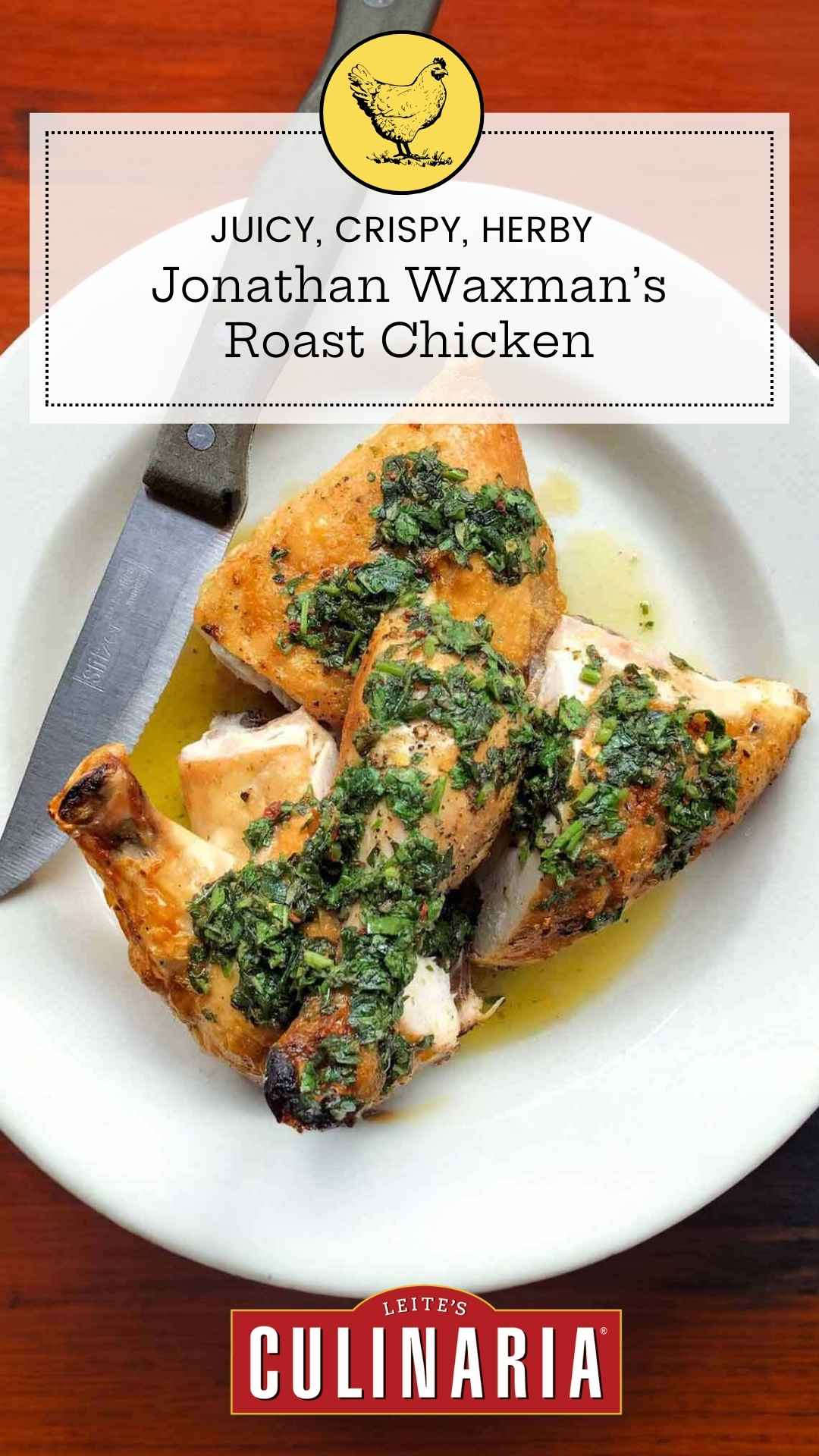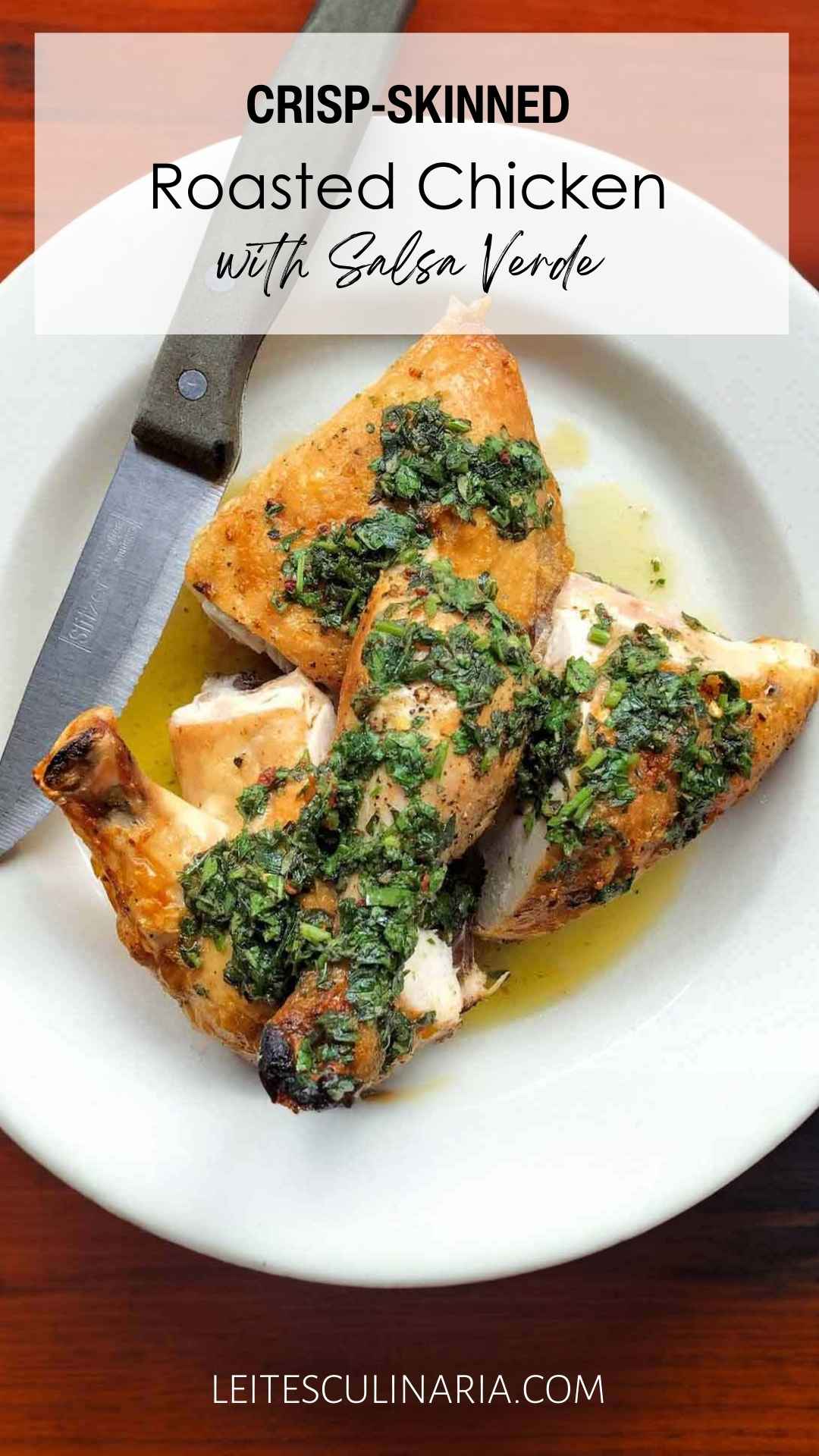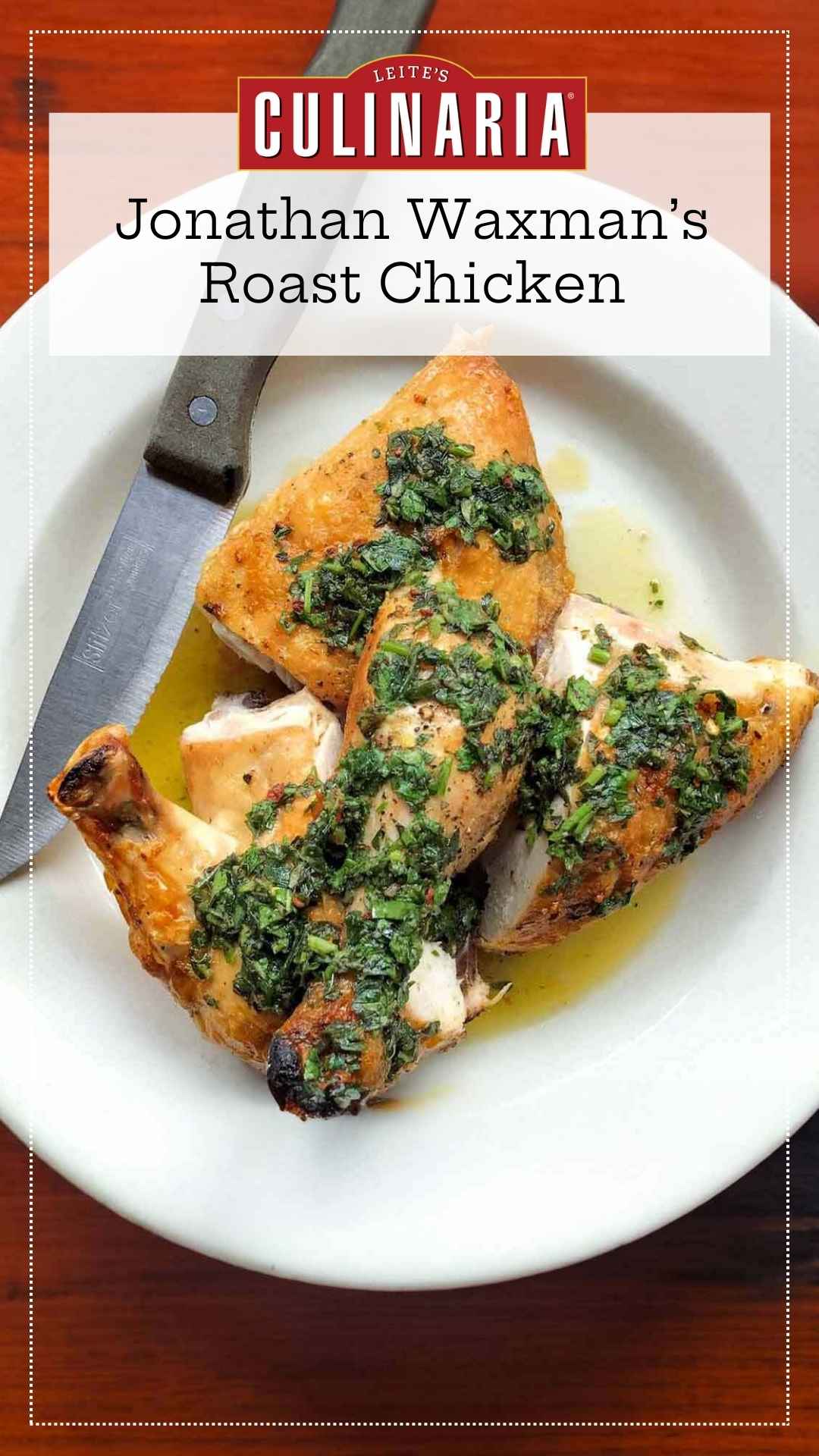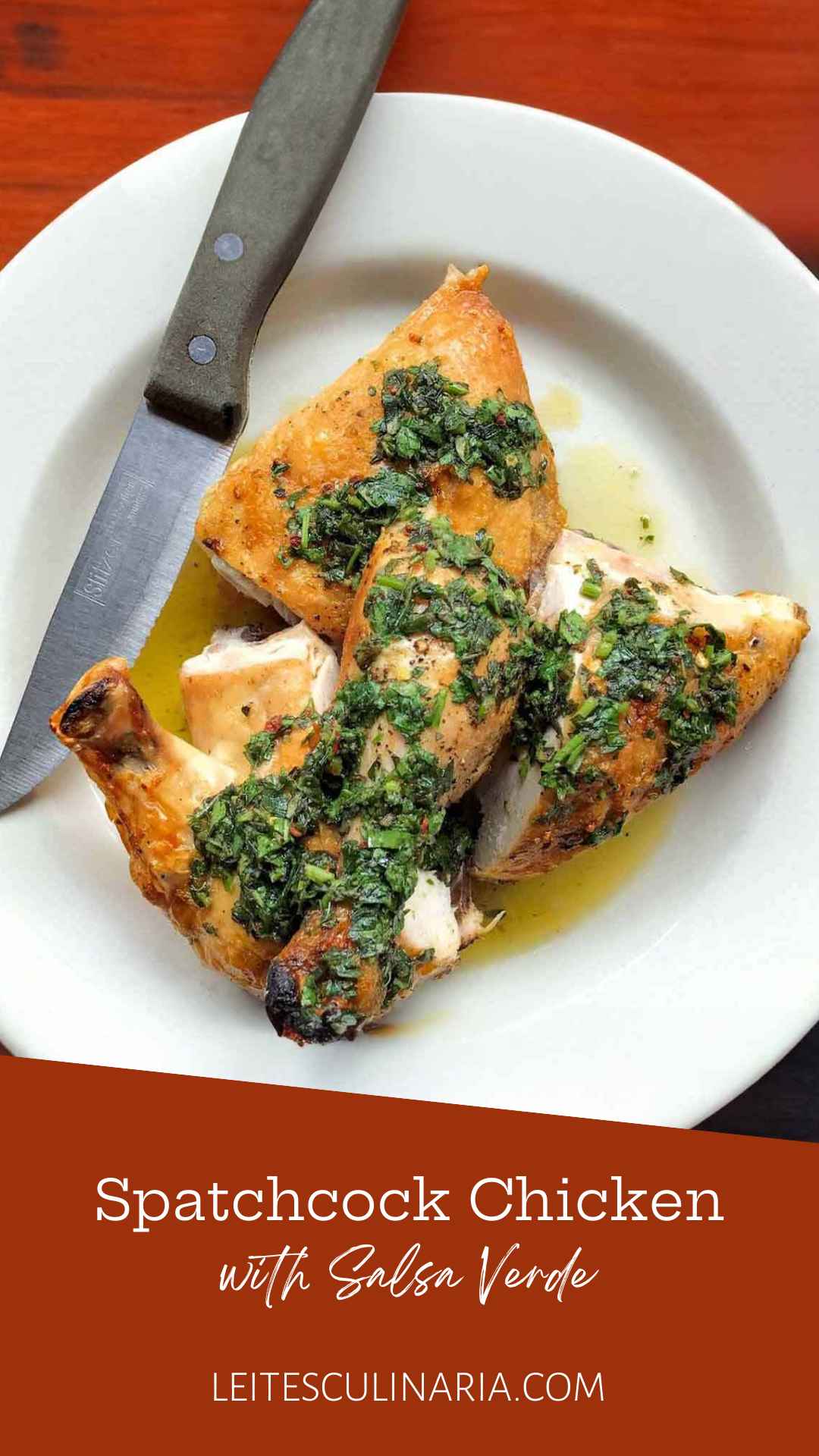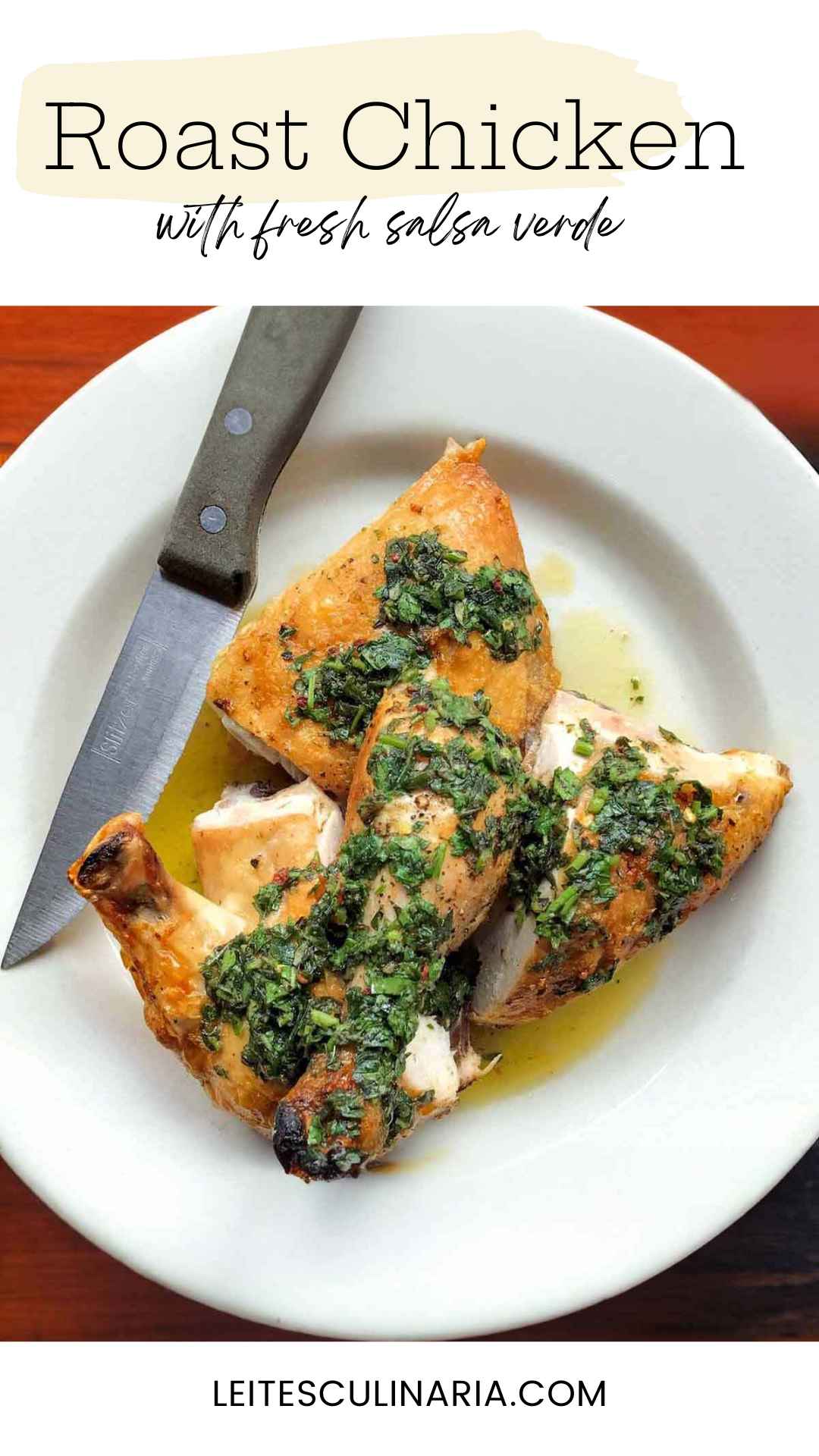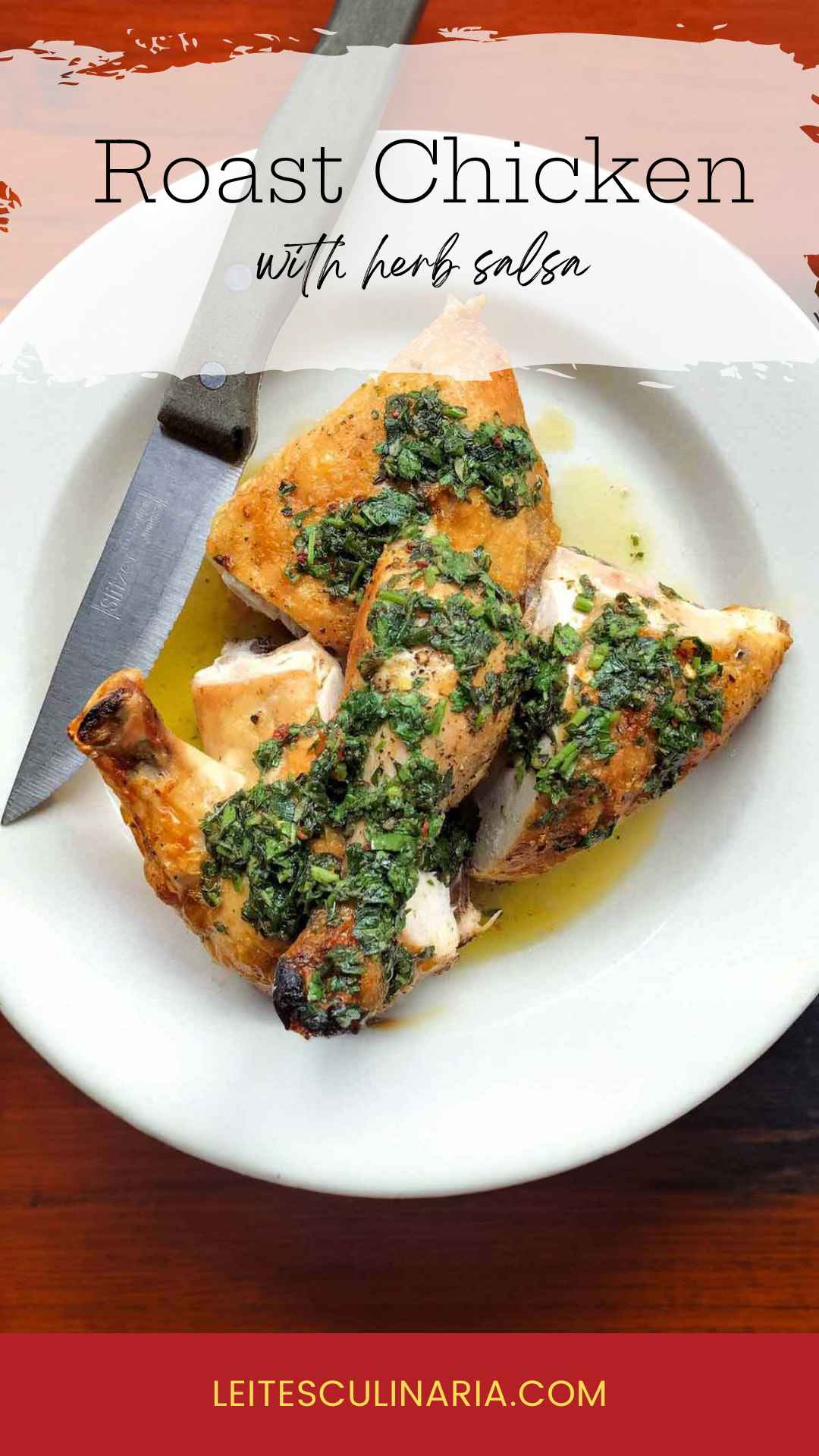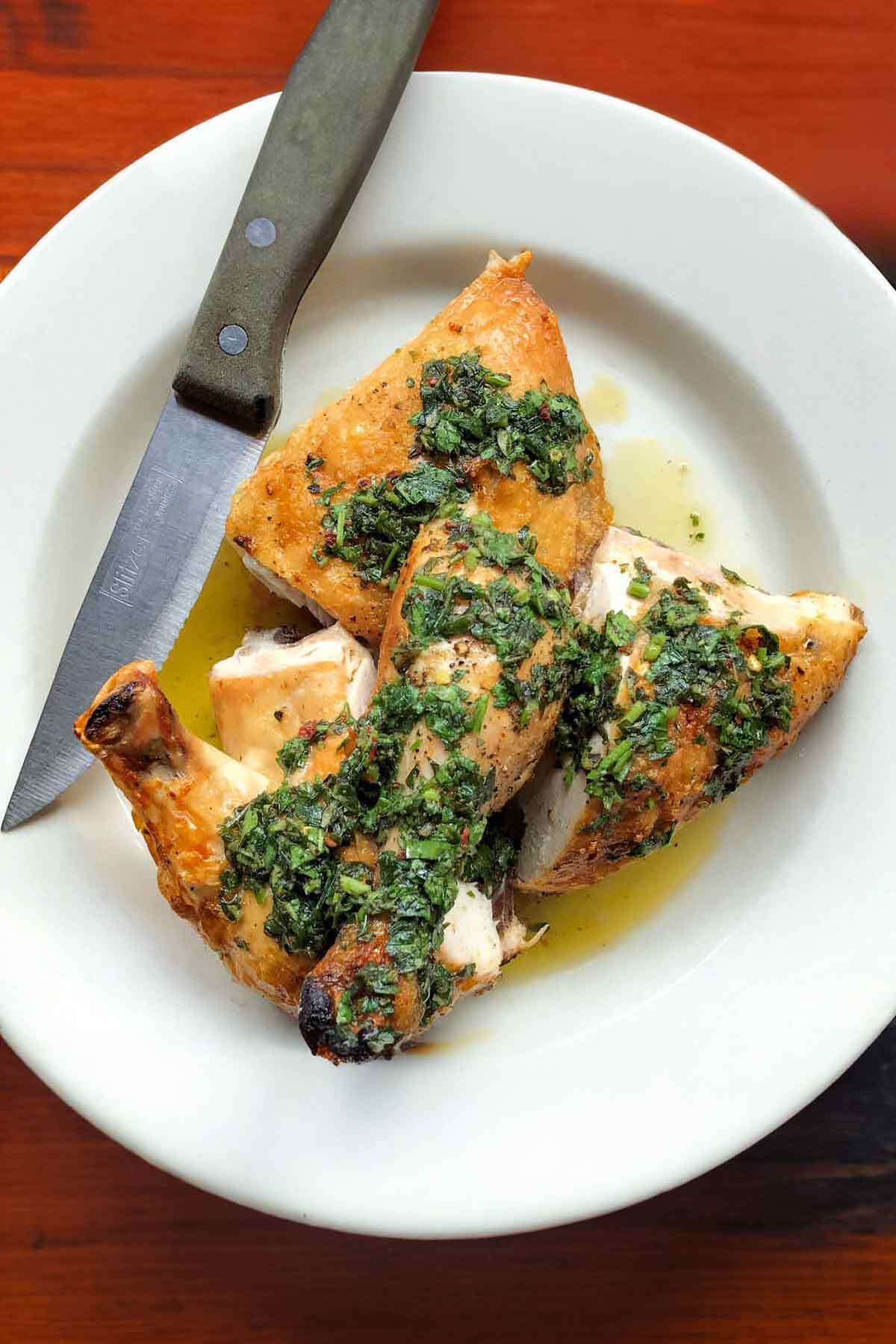
The method is simple: Cut the chicken in half and remove the backbone. Next, cut off the wings so that only the little drumstick is attached. Next, carefully carve out the breastplate. The next step is to rub with olive oil, and then sprinkle with salt and fresh black pepper. Because the chicken has lost some weight in the butchering process, cooking time is vastly reduced to no more than half an hour.
Want to Make Gravy?
Wait! Don’t toss those drippings. See those caramelized brown bits at the bottom of the pan? Those are flavor bombs. If you want to turn them into liquid gold—without a single lump—watch my new video on How to Make No-Fail Pan Gravy. It comes together in 15 minutes while the bird rests.
Want to save this?
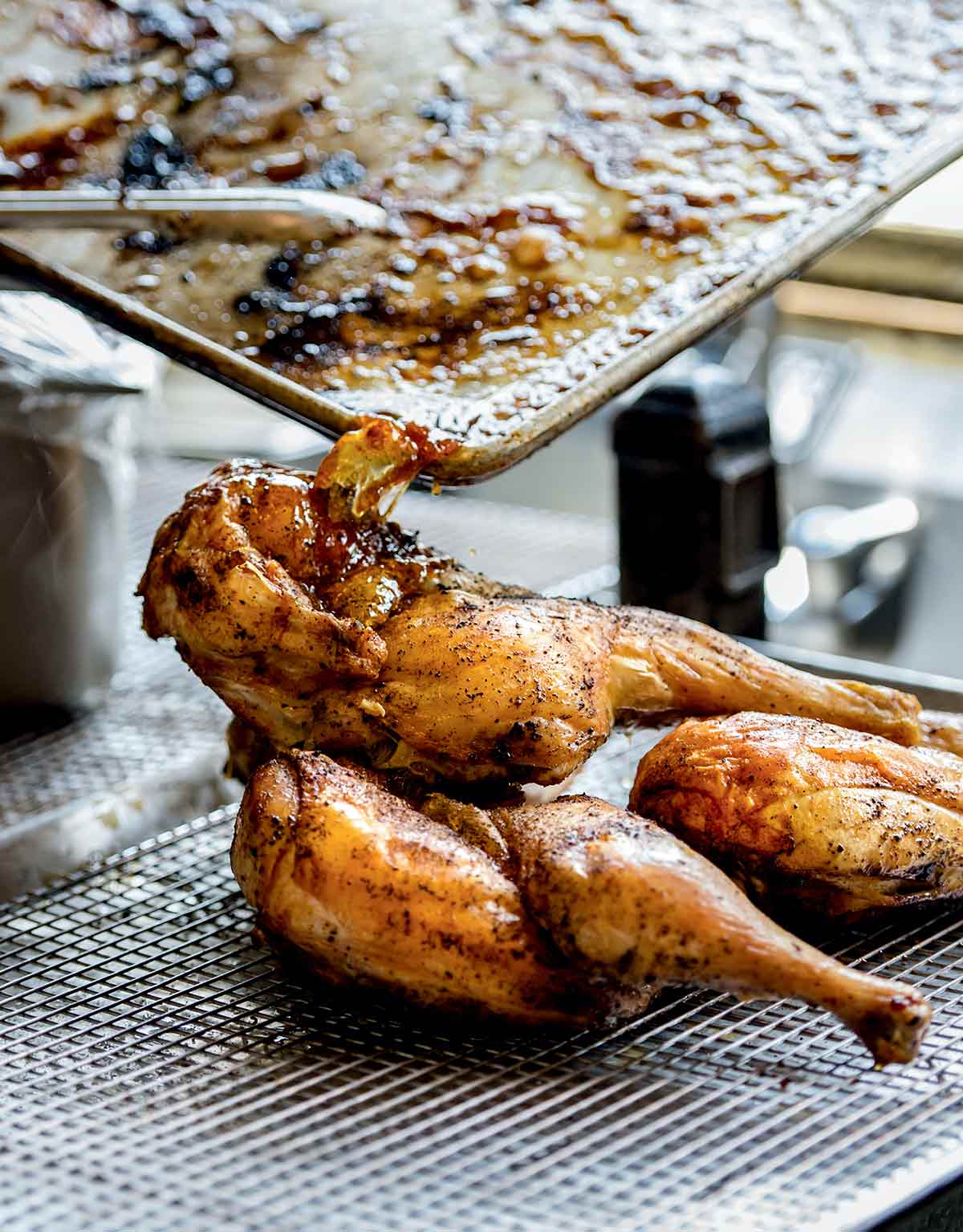
Can I Halve a Recipe for Roast Chicken?
I’m not going to tell you that it’s crazy to not want leftover chicken—you’re your own boss. If you want to go smaller here, it is possible. The beauty of spatchcocking a chicken is that, essentially, you end up with 2 chicken halves. See where I’m going here? You can spatchcock your chicken and then cut through the breastbone as well, leaving you with 2 separate chicken halves. Freeze one half and cook the other. Cook it in exactly the same way as described here, being mindful that you’ll need less time. Whether you only make half a recipe of that herby, salty, salsa is totally up to you.
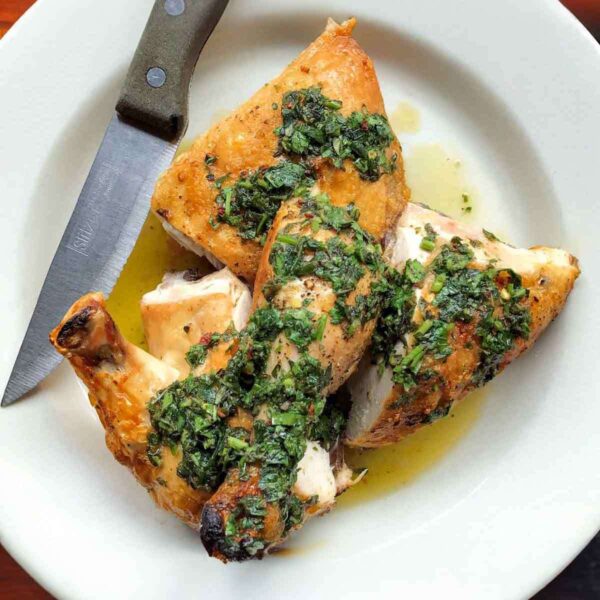
Jonathan Waxman’s Roast Chicken
Ingredients
For the roasted chicken
- One (3 1/2-pound) whole chicken, preferably fresh, spatchcocked
- Sea salt and freshly ground black pepper
- 1/4 cup extra-virgin olive oil
For the salsa verde
- 1/4 cup capers in salt
- 4 salt-cured anchovies, rinsed and deboned
- 3 cloves garlic, peeled
- 1/2 cup chopped fresh parsley
- 1/2 cup chopped arugula
- 1/2 cup chopped fresh basil
- 1/2 cup chopped fresh cilantro
- 1/4 cup chopped fresh tarragon
- 1/4 cup chopped fresh chives
- 1/4 cup chopped fresh sage
- 1 cup extra-virgin olive oil
- 1/4 teaspoon sea salt
Instructions
Make the roasted chicken
- Preheat the oven to 450°F (230°C).
- Pat the chicken completely dry with paper towels.
- Place the chicken, breast side down, on a cutting board. Using a heavy chef ’s knife, cut out the breastbone and snip off the wingtips. Season the two halves with salt and pepper.
- Slick a roasting pan or cast-iron skillet with 2 tablespoons oil. Place the chicken halves, skin side up, in the roasting pan and drizzle with the remaining oil. Roast the chicken until cooked through and the internal temperature is 165°F (74°C), basting every 10 minutes, 30 to 35 minutes. If it's not browning well, turn it over after 15 minutes, and then return it to skin side up for the last 5 minutes.
- Place the chicken halves on a platter, and drain excess fat from the roasting pan. Let rest for at least 30 minutes.
Make the salsa verde
- While the bird is roasting, soak the capers in cold water for 1 hour, then drain.
- Soak the anchovies in cold water for 15 minutes, then pat dry.
- Using a mortar and pestle or small food processor, smash together the capers, anchovies, and garlic until smooth, then dump into a large bowl.
- Add all the herbs and oil. Season with salt. It should be chunky, not oily.
Serve
- When ready to serve, return the bird to the roasting pan and place back in the oven for 5 to 8 minutes to warm through. Remove and cut the bird into serving pieces. Cut each breast in half and cut the thighs from the legs. Serve with the salsa verde, if desired.
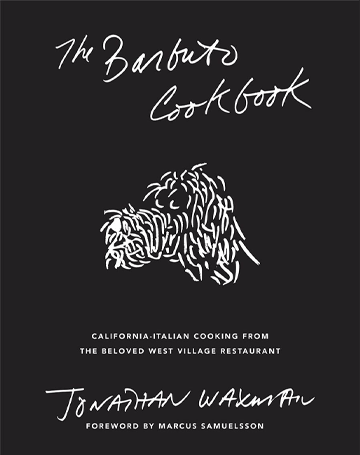
Explore More with AI
Nutrition
Nutrition information is automatically calculated, so should only be used as an approximation.
Recipe Testers’ Reviews
Often there’s an inverse relationship between the mess in my kitchen and the deliciousness of the dish. Splattered fat on the oven walls and splattered fat where I set the pan to baste the chicken didn’t stop me from truly enjoying Jonathan Waxman’s roast chicken. With the salsa verde drizzled over the chicken, it was a mouthful of goodness in every bite.
My chicken was significantly under 3 and 1/2 pounds but cooked in 30 minutes. It didn’t brown as much as I would’ve liked, perhaps next time I’ll cook it on a higher shelf or give it a quick run under the broiler. I had no trouble following the directions for butchering the chicken. As for the “fresh not frozen” chicken, I think that it is always best to use the finest ingredients you can obtain and afford. I think it would be a great meal even if the chicken was frozen.
I cooked mine in a 12 inch cast-iron skillet and removed it from the oven for basting so that the oven temp wouldn’t drop. Hence the splattering. I did flip it over for a bit but removed it from the oven after 30 minutes. I rested it for 30 minutes, who doesn’t like a well-rested bird!
I served it with the salsa verde and because of the size of my bird it would only serve 3 but I think a 3 1/2 pound chicken would serve 4.
The salsa verde is delicious. My local grocer doesn’t carry salt-cured anchovies or capers in salt. I think it’s worth obtaining these at a specialty market but I’d say that you can make a delicious salsa verde using canned anchovies or anchovy paste and capers in brine. This uses a lot of herbs, it is wonderful to be able to pick them out of the garden in the summer, the winter makes it a bit more challenging. I think you can be flexible with the herbs, adding and subtracting what you like. It did come out a bit oily, but stirring it up prior to serving did help. It makes more than I could use on a whole chicken but I think it would be delicious on any steamed vegetables, potatoes, or even on simple seared rib eye steak.
I can always use another weeknight dinner that doesn’t take advance planning yet is satisfying and adaptable. My local butcher had an irresistible deal on free-range, antibiotic-free, air-chilled chicken. The smallest one was over four pounds and would take a bit longer to cook, but when the butcher willingly spatchcocked it for me, all I had to do at home was remove the breastbone and wingtips while the oven pre-heated. The seasoning is dead plain, but if you were inclined to add some oregano or other spices you can do so confidently.
I didn’t have the salsa verde herbs on hand, but I did have a good piquant alternative, with preserved lemon and a bit of honey and olive oil. I did give this larger bird an extra 12-15 minutes. Even though it was not brined, the breast meat turned out perfectly moist and all was nicely browned. Temperature checking easily 165-172℉ internally (using a Thermapen). I was able to slide a tray of spicy roasted Brussels sprouts alongside to roast in parallel.
Since we only planned on serving half, I reserved the other half for the next day while returning just what would be eaten to the oven for the final reheat. I reserved meat juices to make a pan sauce the next day for variety. A simple weeknight dinner of this Jonathan Waxman roast chicken, a glass of Pinot Noir and we were all set.
Jonathan Waxman’s roast chicken is a fantastic, simple, recipe for roast chicken. Using chicken halves ensures a faster roasting time and easier serving. I’d recommend having your butcher do the spatchcocking as the recipe suggests. I struggled a bit with this step and it would have been easier had I just asked an expert.
Even with that minor issue, the recipe pulled together marvelously quickly and resulted in a dish that was simple and comforting. The chicken was moist enough that I didn’t add any sort of sauce. Had a simple dinner of this chicken, rice, and broccoli with peanut sauce.
This Jonathan Waxman’s roast chicken recipe is really fantastic if you’re craving a whole roasted chicken and don’t have the hours to spare. The recipe still takes some time but is nowhere near the amount of time it would usually take. As someone who is completely new to the world of spatchcocking a whole bird, it was incredibly easy (once you’ve watched a few YouTube videos on how to do it) so don’t shy away from this recipe just because it’s spatchcocked.
The bird was incredibly juicy with nice and crisp skin. Just follow the visual cues of the chicken (skin browning, juices running clear, etc.) and not necessarily the timing in the recipe and you won’t be disappointed. I may not return to regular whole roast chickens again.
I spatchcock my birds 99% of the time, so it was the salsa verde that enticed me to make this recipe for Jonathan Waxman’s roast chicken. The simple seasoning, roasting, basting, and resting of the bird results in a very succulent bite of chicken. Topping it with this wonderfully herbaceous salsa, with the sage made each bite even more spectacular. My better half was “mmmming” the whole time she ate the chicken. I’ve been advised that I had better make it for her again.
That noted, I will say breaking down the chicken is pretty easy, but chopping all the herbs will take some time, and I did that as the bird roasted. I used my All-Clad mini prep to blitz the rough-cut herbs with a quarter cup of oil, then added the rest of the ingredients. I think that process made for a more homogenous salsa verde.
Roast chicken is always a favorite and this Jonathan Waxman roast chicken was a good one. The preparation methods described were helpful and took spatchcocking to a new level. I did like removing the breastbone, as suggested, and it made for much easier service.
I do think that the higher cooking temperature of 450°F degrees ensures crispy skin and a juicy interior—solving the common problem of dried-out chicken; 2 checks so far. The sea salt, pepper, and olive oil for seasoning was just fine, but nothing special. I cooked it in a 12″ cast iron pan which works quite well in the hot oven. The salsa verde included in the recipe was quite good. While it was easy to prepare, I would have enlisted a mini-chop processor rather than a mortar and pestle. I think it would have helped with emulsification, and if your mortar and pestle isn’t sizable, it may be difficult to smash until all is smooth.
